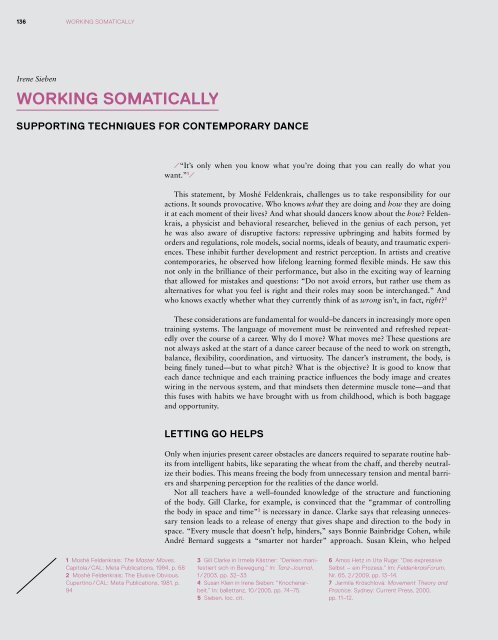Dance Techniques 2010
What does today's contemporary dance training look like? Seven research teams at well known European dance universities have tackled this question by working with and querying some of contemporary dance s most important teachers: Alan Danielson, Humphrey/Limón Tradition, Anouk van Dijk, Countertechnique, Barbara Passow, Jooss Leeder Technique, Daniel Roberts Cunningham Technique, Gill Clarke Minding Motion, Jennifer Muller Muller Technique, Lance Gries Release and Alignment Oriented Techniques. This comprehensive study includes interviews, scholarly contributions, and supplementary essays, as well as video recordings and lesson plans. It provides a comparative look into historical contexts, movement characteristics, concepts, and teaching methods. A workbook with two training DVDs for anyone involved in dance practice and theory. Ingo Diehl, Friederike Lampert (Eds.), Dance Techniques 2010 – Tanzplan Germany. With two DVDs. Berlin: Henschel 2011. ISBN 978-3-89487-689-0 (Englisch) Out of print.
What does today's contemporary dance training look like? Seven research teams at well known European dance universities have tackled this question by working with and querying some of contemporary dance s most important teachers: Alan Danielson, Humphrey/Limón Tradition, Anouk van Dijk, Countertechnique, Barbara Passow, Jooss Leeder Technique, Daniel Roberts Cunningham Technique, Gill Clarke Minding Motion, Jennifer Muller Muller Technique, Lance Gries Release and Alignment Oriented Techniques.
This comprehensive study includes interviews, scholarly contributions, and supplementary essays, as well as video recordings and lesson plans. It provides a comparative look into historical contexts, movement characteristics, concepts, and teaching methods. A workbook with two training DVDs for anyone involved in dance practice and theory.
Ingo Diehl, Friederike Lampert (Eds.), Dance Techniques 2010 – Tanzplan Germany. With two DVDs. Berlin: Henschel 2011. ISBN 978-3-89487-689-0 (Englisch) Out of print.
You also want an ePaper? Increase the reach of your titles
YUMPU automatically turns print PDFs into web optimized ePapers that Google loves.
136 Working Somatically<br />
Irene Sieben<br />
Working Somatically<br />
Supporting techniques for contemporary dance<br />
“It’s only when you know what you’re doing that you can really do what you<br />
want.” 1 <br />
This statement, by Moshé Feldenkrais, challenges us to take responsibility for our<br />
actions. It sounds provocative. Who knows what they are doing and how they are doing<br />
it at each moment of their lives? And what should dancers know about the how? Feldenkrais,<br />
a physicist and behavioral researcher, believed in the genius of each person, yet<br />
he was also aware of disruptive factors: repressive upbringing and habits formed by<br />
orders and regulations, role models, social norms, ideals of beauty, and traumatic experiences.<br />
These inhibit further development and restrict perception. In artists and creative<br />
contemporaries, he observed how lifelong learning formed flexible minds. He saw this<br />
not only in the brilliance of their performance, but also in the exciting way of learning<br />
that allowed for mistakes and questions: “Do not avoid errors, but rather use them as<br />
alternatives for what you feel is right and their roles may soon be interchanged.” And<br />
who knows exactly whether what they currently think of as wrong isn’t, in fact, right? 2<br />
These considerations are fundamental for would–be dancers in increasingly more open<br />
training systems. The language of movement must be reinvented and refreshed repeatedly<br />
over the course of a career. Why do I move? What moves me? These questions are<br />
not always asked at the start of a dance career because of the need to work on strength,<br />
balance, flexibility, coordination, and virtuosity. The dancer’s instrument, the body, is<br />
being finely tuned—but to what pitch? What is the objective? It is good to know that<br />
each dance technique and each training practice influences the body image and creates<br />
wiring in the nervous system, and that mindsets then determine muscle tone—and that<br />
this fuses with habits we have brought with us from childhood, which is both baggage<br />
and opportunity.<br />
Letting go helps<br />
Only when injuries present career obstacles are dancers required to separate routine habits<br />
from intelligent habits, like separating the wheat from the chaff, and thereby neutralize<br />
their bodies. This means freeing the body from unnecessary tension and mental barriers<br />
and sharpening perception for the realities of the dance world.<br />
Not all teachers have a well–founded knowledge of the structure and functioning<br />
of the body. Gill Clarke, for example, is convinced that the “grammar of controlling<br />
the body in space and time” 3 is necessary in dance. Clarke says that releasing unnecessary<br />
tension leads to a release of energy that gives shape and direction to the body in<br />
space. “Every muscle that doesn’t help, hinders,” says Bonnie Bainbridge Cohen, while<br />
André Bernard suggests a “smarter not harder” approach. Susan Klein, who helped<br />
1 Moshé Feldenkrais: The Master Moves.<br />
Capitola / CAL: Meta Publications, 1984, . p. 68<br />
2 Moshé Feldenkrais: The Elusive Obvious.<br />
Cupertino / CAL: Meta Publications, 1981. p.<br />
94<br />
3 Gill Clarke in Irmela Kästner: “Denken manifestiert<br />
sich in Bewegung.” In: Tanz-Journal,<br />
1 / 2003, pp. 32–33<br />
4 Susan Klein in Irene Sieben: “Knochenarbeit.”<br />
In: ballettanz, 10 / 2005, pp. 74–75.<br />
5 Sieben, loc. cit.<br />
6 Amos Hetz in Uta Ruge: “Das expressive<br />
Selbst – ein Prozess.” Im: FeldenkraisForum,<br />
Nr. 65, 2 / 2009, pp. 13–14.<br />
7 Jarmila Kröschlová: Movement Theory and<br />
Practice. Sydney: Current Press, 2000,<br />
pp. 11–12.


















